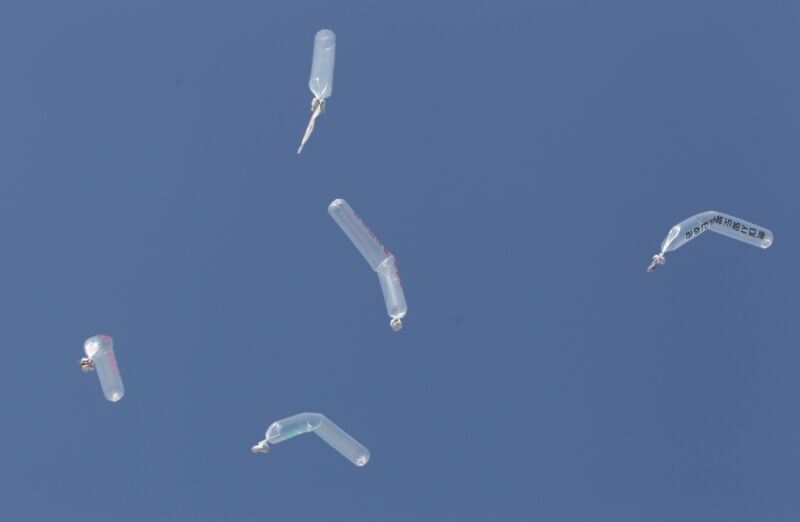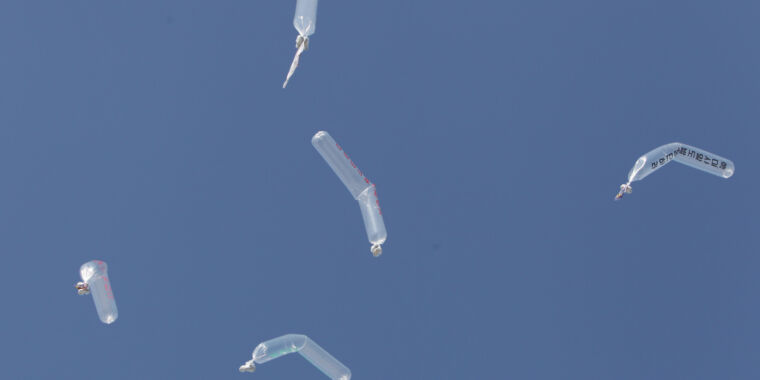Windblown 'alien things' caused massive COVID outbreak, North Korea says
 Enlarge / North Korean defectors, currently living in South Korea, release balloons carrying anti - North Korea, February 16, 2013, in Paju, South Korea.
Getty | Chung Sung Jun
Enlarge / North Korean defectors, currently living in South Korea, release balloons carrying anti - North Korea, February 16, 2013, in Paju, South Korea.
Getty | Chung Sung Jun
After intense and detailed investigation, North Korea has determined what sparked an explosive outbreak of COVID-19 that has caused more than 4.7 million "fevers" within its borders since late April . The culprit: "alien things" blown into the country from the South.
According to a report by the official KCNA news agency, North Korea's outbreak began in early April when an 18-year-old soldier and a five-year-old kindergarten student made contact with "extraterrestrial things in a hill" in the area. of Ipho-ri in Kumgang County, which is in the southeast corner of the country near the border. Both later tested positive for the novel coronavirus, and epidemiological analyzes revealed that these cases were solely the source of the nationwide outbreak; both infections are linked to further spread in Kumgang and from there to the rest of North Korea.
“It was also established,” the report states, “that fever cases reported in all regions and units of the country, except Ipho-ri region up to mid-April , were due to other diseases." The report contains no information on how officials reached this conclusion.
The report also does not provide any clues as to the identity of the "extraterrestrial things" that may have triggered the outbreak in the country. But experts outside the secretive and authoritarian country suggest the report is just an attempt to shift blame for the outbreak and invoke fear and hatred of South Korea. For decades North Korean activists and defectors in South Korea have launched balloons loaded with leaflets, aid and other items over the border.
North Korean officials have now issued guidelines "emphasizing the need to deal vigilantly with extraterrestrials from wind and other weather and balloon phenomena in areas along the demarcation line and borders."
In terms of the risk of SARS-CoV-2 transmission, spread from contaminated objects or surfaces (called fomite transmission) is possible, but the risk is considered very low. Some studies have suggested that the risk of contracting SARS-CoV-2 infection from a contaminated surface is less than 1 in 10,000. The virus is mainly spread via respiratory droplets between people close to each other .
North Korean officials aren't the only ones in the region making questionable transmission claims. Last month, officials in the Chinese city of Dandong, which borders North Korea, suggested that wind blowing in from North Korea could explain the steady stream of new infections in the city. Although there is no evidence to suggest SARS-CoV-2 is spread by wind over long distances, authorities have advised residents living along the border to close their windows in 'southern weather' .

 Enlarge / North Korean defectors, currently living in South Korea, release balloons carrying anti - North Korea, February 16, 2013, in Paju, South Korea.
Getty | Chung Sung Jun
Enlarge / North Korean defectors, currently living in South Korea, release balloons carrying anti - North Korea, February 16, 2013, in Paju, South Korea.
Getty | Chung Sung Jun
After intense and detailed investigation, North Korea has determined what sparked an explosive outbreak of COVID-19 that has caused more than 4.7 million "fevers" within its borders since late April . The culprit: "alien things" blown into the country from the South.
According to a report by the official KCNA news agency, North Korea's outbreak began in early April when an 18-year-old soldier and a five-year-old kindergarten student made contact with "extraterrestrial things in a hill" in the area. of Ipho-ri in Kumgang County, which is in the southeast corner of the country near the border. Both later tested positive for the novel coronavirus, and epidemiological analyzes revealed that these cases were solely the source of the nationwide outbreak; both infections are linked to further spread in Kumgang and from there to the rest of North Korea.
“It was also established,” the report states, “that fever cases reported in all regions and units of the country, except Ipho-ri region up to mid-April , were due to other diseases." The report contains no information on how officials reached this conclusion.
The report also does not provide any clues as to the identity of the "extraterrestrial things" that may have triggered the outbreak in the country. But experts outside the secretive and authoritarian country suggest the report is just an attempt to shift blame for the outbreak and invoke fear and hatred of South Korea. For decades North Korean activists and defectors in South Korea have launched balloons loaded with leaflets, aid and other items over the border.
North Korean officials have now issued guidelines "emphasizing the need to deal vigilantly with extraterrestrials from wind and other weather and balloon phenomena in areas along the demarcation line and borders."
In terms of the risk of SARS-CoV-2 transmission, spread from contaminated objects or surfaces (called fomite transmission) is possible, but the risk is considered very low. Some studies have suggested that the risk of contracting SARS-CoV-2 infection from a contaminated surface is less than 1 in 10,000. The virus is mainly spread via respiratory droplets between people close to each other .
North Korean officials aren't the only ones in the region making questionable transmission claims. Last month, officials in the Chinese city of Dandong, which borders North Korea, suggested that wind blowing in from North Korea could explain the steady stream of new infections in the city. Although there is no evidence to suggest SARS-CoV-2 is spread by wind over long distances, authorities have advised residents living along the border to close their windows in 'southern weather' .
What's Your Reaction?








![Judge Delays Musk/Twitter Lawsuit, Gives Them Three Weeks to Complete Merger [Updated]](https://vidianews.com/assets/img/bg_slider.png)
![Judge Delays Musk/Twitter Lawsuit, Gives Them Three Weeks to Complete Merger [Updated]](https://cdn.arstechnica.net/wp-content/uploads/2022/08/getty-musk-twitter-760x380.jpg)












